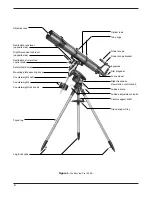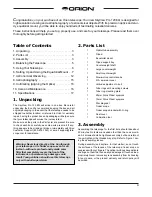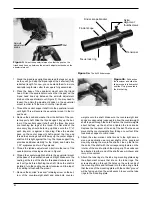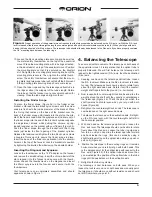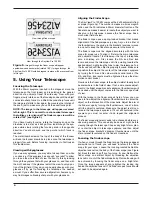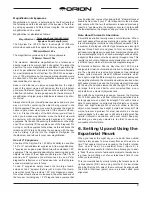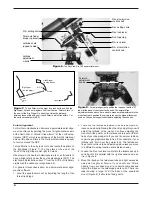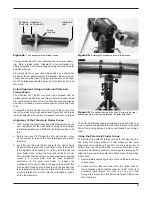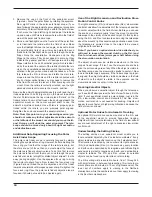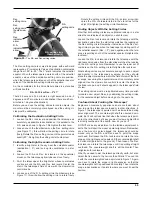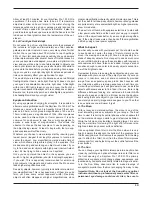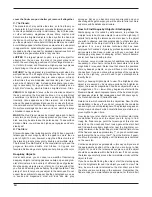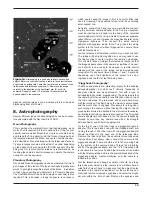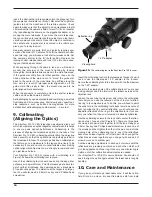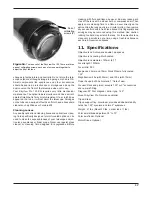
3. Remove the cap on the front of the equatorial mount
(Figure 6). Focus the polar finder by rotating the eyepiece.
Now, sight Polaris in the polar axis finder scope. If you
have followed the approximate polar alignment procedure
accurately, Polaris will probably be within the field of view.
If not, move the tripod left-to-right, and adjust the latitude
up-and down until Polaris is somewhere within the field of
view of the polar axis finder scope.
4. Shine a red flashlight down the front end of the polar find-
er to illuminate the reticle within the field of view. Make
sure the flashlight shines in at an angle, so as not to block
the polar finder’s field of view. It may be helpful to have a
friend hold the flashlight while you look through the polar
finder. Note the constellation Cassiopeia and the Big
Dipper in the reticle. They do not appear in scale, but they
indicate the general positions of Cassiopeia and the Big
Dipper relative to the north celestial pole (which is indicat-
ed by the cross at the center of the reticle). Rotate the reti-
cle so the constellations depicted match their current ori-
entation in they sky when viewed with the naked eye. To do
this, release the R.A. lock lever and rotate the main tele-
scope around the R.A. axis until the reticle is oriented with
sky. For larger optical tubes, you may need to remove the
tube from the mount to prevent it from bumping into the
mount. Once the reticle is correctly oriented, use the right
ascension lock lever to secure the mount’s position.
Now use the azimuth adjustment knobs (Figure 8) and the lat-
itude adjustment L-bolts (Figure 6) on the mount to position
the star Polaris inside the tiny circle marked “Polaris” on the
finder’s reticle. You must first loosen the knob underneath the
equatorial mount on the center support shaft to use the
azimuth adjustment knobs. Once Polaris is properly posi-
tioned within the reticle, you are precisely polar aligned.
Retighten the knob underneath the equatorial mount
Note: From this point on in your observing session, you
should not make any further adjustments in the azimuth
or the latitude of the mount, nor should you move the tri-
pod. Doing so will undo the polar alignment. The tele-
scope should be moved only about its right ascension
and declination axes.
Additional Note Regarding Focusing the Polar
Axis Finder Scope
The polar axis finder scope is normally focused by simply
rotating the eyepiece focus ring. However, if after adjusting the
focus ring you find that the image of the reticle is sharp, but
the stars are out of focus, then you must adjust the focus of
the polar axis finder’s objective lens. To do this, first remove
the polar axis finder from the mount. Look through the polar
axis finder at a star (at night) or distant object at least 1/4 mile
away (during daylight). Use the eyepiece focus ring to bring
the reticle into sharp focus. Now, loosen the focus lock ring
(Figure 9a) and thread the entire objective end of the finder
inwards or outwards until images appear sharp. Re-tighten the
focus lock ring. Once the polar axis finder’s objective lens is
focused, it should not need to be adjusted again.
Use of the Right Ascension and Declination Slow-
Motion Control Knobs
The right ascension (R.A.) and declination (Dec.) slow-motion
control knobs allow fine adjustment of the telescope’s position
to center objects within the field of view. Before you can use
the knobs, you must manually “slew” the mount to point the
telescope in the vicinity of the desired target. Do this by loos-
ening the R.A. and Dec. lock levers and moving the telescope
about the mount’s right ascension and declination axes. Once
the telescope is pointed close to the object to be viewed,
retighten both lock levers.
Note: If you have an optional motor drive attached, you
will need to loosen the manual clutch on the R.A. (and
Dec. for dual-axis drives) worm gear shaft before using
the slow-motion control knob.
The object should now be visible somewhere in the tele-
scope’s finder scope. If it isn’t, use the slow-motion knobs to
scan the surrounding area of sky. When the object is visible in
the finder scope, use the slow-motion knobs to center it. Now,
look in the telescope’s eyepiece. If the finder scope is proper-
ly aligned, the object should be visible somewhere in the field
of view. Once the object is visible in the eyepiece, use the
slow-motion knobs to center it in the field of view.
Tracking Celestial Objects
When you observe a celestial object through the telescope,
you’ll see it drift slowly across the field of view. To keep it in the
field, if your equatorial mount is polar aligned, just turn the
R.A. slow-motion control knob clockwise. The Dec. slow-
motion control knob is not needed for tracking. Objects will
appear to move faster at higher magnifications, because the
field of view is narrower.
Optional Motor Drives for Automatic Tracking
An optional DC motor drive can be mounted on the R.A. axis
of the equatorial mount to provide hands-free tracking.
Objects will then remain stationary in the field of view without
any manual adjustment of the right ascension slow-motion
control knob.
Understanding the Setting Circles
The setting circles on an equatorial mount enable you to
locate celestial objects by their “celestial coordinates”. Every
object resides in a specific location on the “celestial sphere”.
That location is denoted by two numbers: its right ascension
(R.A.) and declination (Dec.). In the same way, every location
on Earth can be described by its longitude and latitude. Right
ascension is similar to longitude on Earth, and declination is
similar to latitude. The R.A. and Dec. values for celestial
objects can be found in any star atlas or star catalog.
The R.A. setting circle is scaled in hours, from 1 through 24,
with small marks in between representing 10-minute incre-
ments (there are 60 minutes in 1 hour of right ascension). The
lower set of numbers apply to viewing in the Northern
Hemisphere, while the numbers above them apply to viewing
in the Southern Hemisphere.
10


